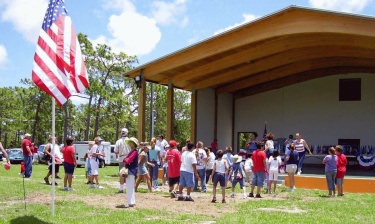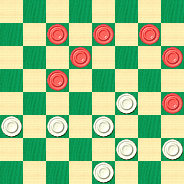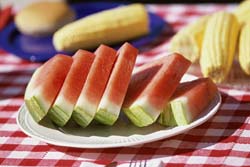The Checker Maven
Jump to navigationFourth of July Picnic

Tommy always looked forward to going to the Fourth of July Picnic with his family. There would be hot dogs, hamburgers, watermelon, ice cream cones, and a host of summer treats. There was the three-legged race, the pie-eating contest, and more fun than could ever be imagined, topped off with an exciting display of fireworks. Tommy's home town in Florida really knew how to celebrate America's birthday.
But this year was even more special. Tommy was going to play in the adult section of the Fourth of July checker tournament! Normally, he would play in the elementary school section, but this year he had managed to get permission to go straight to the top and play with the grownups.

Now, Tommy had been studying checkers every Saturday morning with Uncle Ben (see our Uncle Ben's Porch series of columns). Uncle Ben wasn't really his uncle, but everyone called him that; and under his mentoring, Tommy had come a long way with his checker skills.
Uncle Ben was at the picnic, of course, but as a full-fledged professional wasn't allowed to enter the tournament. Tommy wanted to make him proud and was determined to play well. But playing against experienced adult checkerists was no easy assignment.
The tournament was "single life" elimination. If you lost your round, or if your game was a draw in two rounds, you were out of the competition.
The first round was about to begin. Tommy was paired with a very tough opponent, 47-year old insurance agent Bob Fernastus, one of the top adult amateurs in the area. Bob was captain of the county champion recreational checker team, the Mutual Farm Draughts Oxen.

Bob Fernastus
They met at their assigned board. "Pleased to meet you, Mr. Fernastus," said Tommy politely as they shook hands. "Same here, young man," said Bob in return; was he perhaps being just a bit condescending to his much younger opponent? But just at that moment, the tournament director gave the call, "Start your clocks!" and the tournament was underway.
Tommy had White and the game unfolded as follows.
| Black: | Bob Fernastus | |
| White: | Tommy | |
| 1. | 12-16 | 22-18 |
| 2. | 8-12 | 25-22 |
| 3. | 16-20 | 24-19 |
| 4. | 4-8 | 22-17 |
| 5. | 9-13 | 30-25 |
| 6. | 13x22 | 26x17 |
| 7. | 10-14 | 17x10 |
| 8. | 7x14 | 18x9 |
| 9. | 5x14 | 25-22 |
| 10. | 6-10 | 22-18 |
| 11. | 1-5 | 18x9 |
| 12. | 5x14 | 29-25 |
| 13. | 11-15 | 25-22 |
| 14. | 15x24 | 28x19 |
| 15. | 3-7 | 32-28 |
| 16. | 2-6 (see diagram) | 28-24 |
| 17. | 8-11 | 22-18 |
| 18. | 6-9 | 18-15 |
| 19. | 11x18 | 21-17 |
| 20. | 14x21 | 23x5 |
| 21. | 7-11 | 27-23 |
| 22. | 20x27 | 31x24 |
| 23. | 21-25 | 5-1 |
| 24. | 11-15 | 1-6 |
Draw Agreed.
"Wow," said Bob, you really had me going there! Great game, Tommy, but do you realize you missed a win at move 16?"
Tommy, pleased to get a draw against a highly skilled adult player, looked puzzled. "A win, Mr. Fernastus? Really?"
"Yes, Tommy, you could have won the game! Do you want me to show you?"
"Yes, sir, if you would ... I had no idea ...."
"Well, then Tommy," Bob continued, "Here it is."

WHITE
White to Play and Win
W:W31,28,27,23,22,21,19:B20,14,12,10,8,7,6.
Could you have found the win where Tommy didn't? We'll warn you, it's subtle and probably well beyond the skills of even a very talented grade schooler. Give it a try and click on Read More when you're ready to see the solution and complete game notes.![]()
Solution
The solution to our problem appears at Note E.
| Black: | Bob Fernastus | |
| White: | Tommy | |
| 1. | 12-16 | 22-18 |
| 2. | 8-12 | 25-22 |
| 3. | 16-20 | 24-19 |
| 4. | 4-8 | 22-17 |
| 5. | 9-13---A | 30-25 |
| 6. | 13x22 | 26x17 |
| 7. | 10-14---B | 17x10 |
| 8. | 7x14 | 18x9 |
| 9. | 5x14 | 25-22 |
| 10. | 6-10---C | 22-18 |
| 11. | 1-5 | 18x9 |
| 12. | 5x14 | 29-25 |
| 13. | 11-15 | 25-22 |
| 14. | 15x24 | 28x19 |
| 15. | 3-7---D | 32-28 |
| 16. | 2-6 | 28-24---E, G |
| 17. | 8-11 | 22-18 |
| 18. | 6-9 | 18-15 |
| 19. | 11x18 | 21-17 |
| 20. | 14x21 | 23x5 |
| 21. | 7-11 | 27-23 |
| 22. | 20x27 | 31x24 |
| 23. | 21-25 | 5-1 |
| 24. | 11-15 | 1-6 |
Draw Agreed.
A---11-16 or 9-14 may be preferable but this move cannot be said to lose.
B---11-16 would still have been a little better; White starts to get a small edge at this point.
C---White has a bit of an advantage in this position according to King's Row, but nothing like a clear win.
D---2-7 would have left White with some advantage, but this move gets Black into deeper trouble and appears to lose, though it takes pretty deep computer analysis to see the distinction with 3-7.
E---31-26 would have won here, for instance
| 16. | ... | 31-26 |
| 17. | 8-11 | 22-17 |
| 18. | 11-15 | 19-16 |
| 19. | 12x19 | 23x16 |
| 20. | 15-18 | 26-23 |
| 21. | 18-22 | 23-19 |
| 22. | 14-18 | 16-12 |
| 23. | 22-26 | 12-8 |
| 24. | 18-22 | 8-3 |
| 25. | 6-9---F | 27-23 |
| 26. | 26-31 | 23-18 |
| 27. | 31-27 | 17-13 |
| 28. | 27-23 | 13x6 |
| 29. | 23x16 | 18-14 |
| 30. | 10x17 | 3x10 |
| 31. | 16-19 | 21x14 |
White Wins.
F---Forced in view of the threat of 19-15.
G---Original published analysis gave 27-24 to win but this too is only good enough to draw.
Tommy politely shook hands with Mr. Fernastus and thanked him for the game and the position analysis. Then, being a grade schooler after all, he headed off to the watermelon stand for some refreshments before the next round began. Bob Fernastus went on to win the Blue Ribbon, with Tommy making it through the first three rounds before another draw knocked him out. The competition at these events can be mighty tough even for the best amateur players.
Postscript: We understand that the Jacksonville Jumpers of the AA Southern Checker League have been talking with Bob Fernastus about a professional contract. It's a rare checkerist who can jump from amateur straight into AA play!

Computer analysis for this column was done with the King's Row engine, using the 10-piece endgame database generously donated by author Ed Gilbert.
You can email the Webmaster with comments on this article.
